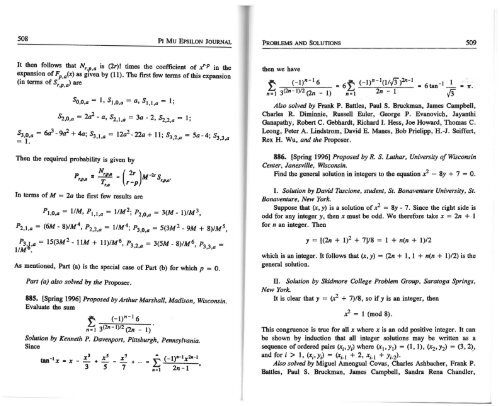Vol. 10 No 6 - Pi Mu Epsilon
Vol. 10 No 6 - Pi Mu Epsilon
Vol. 10 No 6 - Pi Mu Epsilon
- No tags were found...
You also want an ePaper? Increase the reach of your titles
YUMPU automatically turns print PDFs into web optimized ePapers that Google loves.
508 PI MU EPSILON JOURNAL<br />
Since<br />
sequence of ordered pairs (x;. Y;) where (x 1<br />
, y 1 ) = (1, 1), (x 2 , y 2 ) = (3, 2)~ ,<br />
x 5 x 1<br />
and fori > 1, (x;.Y;) = (x;_ 1 + 2,<br />
+--<br />
s 7 + ... X;_ 1 + Yi-2).<br />
Also solved by Miguel Amengual Covas, Charles Ashbacher, Frank P.<br />
Battles, Paul S. Bruckman, James Campbell, Sandra Rena Chandler,<br />
PROBLEMS AND SOLUTIONS 509<br />
It then . follows that N r,p,a is (2r)! times the coefficient of x--p 1"n the<br />
then we have<br />
e~pans<strong>10</strong>n of Fp,a(x) as given by (11). The first few terms of this expansion<br />
(ID terms of Sr,p,a) are<br />
~ (-l)n-1 6 _ ~ (-l)n-1(11J3")2n-1 _ _ 1 1<br />
L .......,.,~..,..,....,;,,----- - 6 L - 6tan _ = 1r.<br />
n"'1 3(2n- 1 ) 12 (2n - 1) n"'1 2n- 1 {3<br />
So,o,a = 1, Sl,O,a = a, S1,1,a = 1;<br />
s2<br />
,<br />
0<br />
'<br />
a = 2a2 - a, s2<br />
•<br />
1<br />
,<br />
a = 3a - 2, s2<br />
,<br />
2<br />
,a<br />
= 1· '<br />
Also solved by Frank P. Battles, Paul S. Bruckman, James Campbell,<br />
Charles R. Diminnie, Russell Euler, George P. Evanovich, Jayanthi<br />
Ganapathy, Robert C. Gebhardt, Richard I. Hess, Joe Howard, Thomas C.<br />
s3,0,a = 6a 3 -9~ + 4a; s3 1 a= 12a 2 Leong, Peter A. Lindstrom, David E. Manes, Bob Prielipp, H.-J. Seiffert,<br />
-22a + 11; s3 2 = 5a-4· s3 3<br />
= 1. , ' ' ,a ' , ,a Rex H. Wu, and the Proposer.<br />
Then the required probability is given by<br />
886. [Spring 1996] Proposed by R. S. Luthar, University of Wisconsin<br />
Center, Janesville, Wisconsin.<br />
p s N,,IJ = ( 2r )M-2r S<br />
Find the general solution in integers to the equation: - 8y + 7 = 0.<br />
r .PIJ T - r ,p,p•<br />
r,p r p<br />
In terms of M = 2a the first few results are<br />
I. Solution by David Tascione, student, St. Bonaventure University, St.<br />
Bonaventure, New York.<br />
P1,o,a = liM, P1,1,a = 11M 2 Suppose that (x, y) is a solution of: = 8y - 7. Since the right side is<br />
; P2,o,a = 3(M- 1)/M3,<br />
odd for any integer y, then x must be odd. We therefore take x = 2n + 1<br />
P2,1,a = (6M- 8)/M 4 , P2,2,a = 11M 4 ; P3,0,a = 5(3M 2 - 9M + 8)/M 5 ,<br />
P3,1,a = 15(3M 2 - llM + ll)/M 6 , P 3 2<br />
= 3(5M- 8)/M6 p =<br />
l!M6. • ,a • 3,3,a<br />
for n an integer. Then<br />
y = [(2n + 1 ) 2 + 7]/8 = 1 + n(n + 1)/2<br />
which is an integer. It follows that (x, y) = (2n + 1, 1 + n(n + 1 )/2) is the<br />
As mentioned, Part (a) is the special case of Part (b) for which p = 0.<br />
Part (a) also solved by the Proposer.<br />
general solution.<br />
II. Solution by Skidmore College Problem Group, Saratoga Springs,<br />
New York.<br />
885. [Spring 1996] Proposed by Arthur Marshall, Madison, Wisconsin.<br />
It is clear that y = (: + 7)/8, so if y is an integer, then<br />
Evaluate the sum<br />
E (-1)n-1 6<br />
n"'1 3(2n- 1 ) 12 (2n- 1).<br />
: = 1 (mod 8).<br />
This congruence is true for all x where x is an odd positive integer. It can<br />
Solution by Kenneth P. Davenport, <strong>Pi</strong>ttsburgh, Pennsylvania.<br />
be shown by induction that all integer solutions may be written as a
















